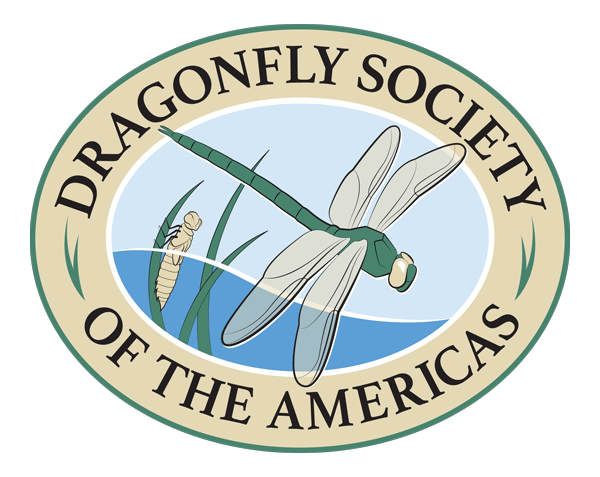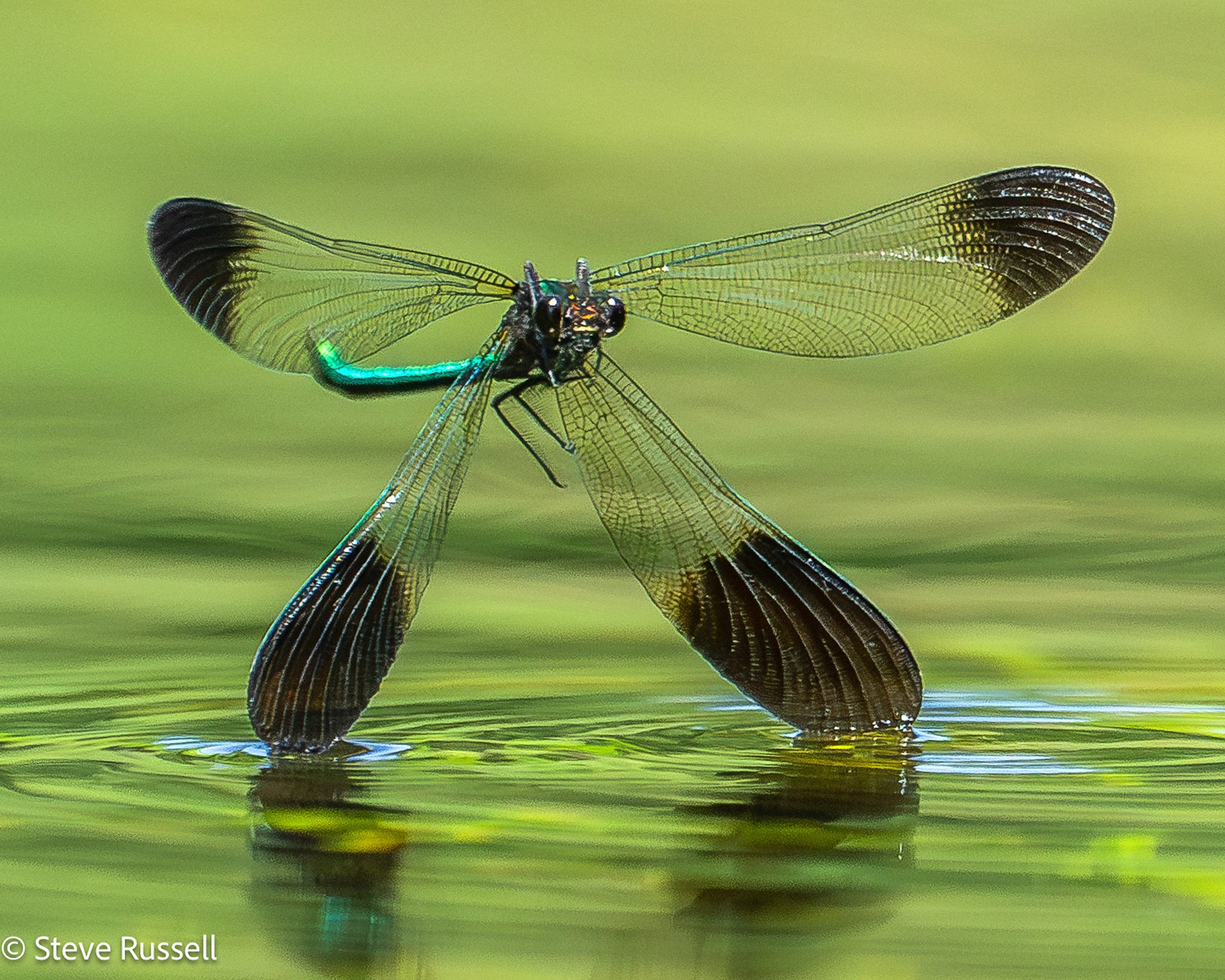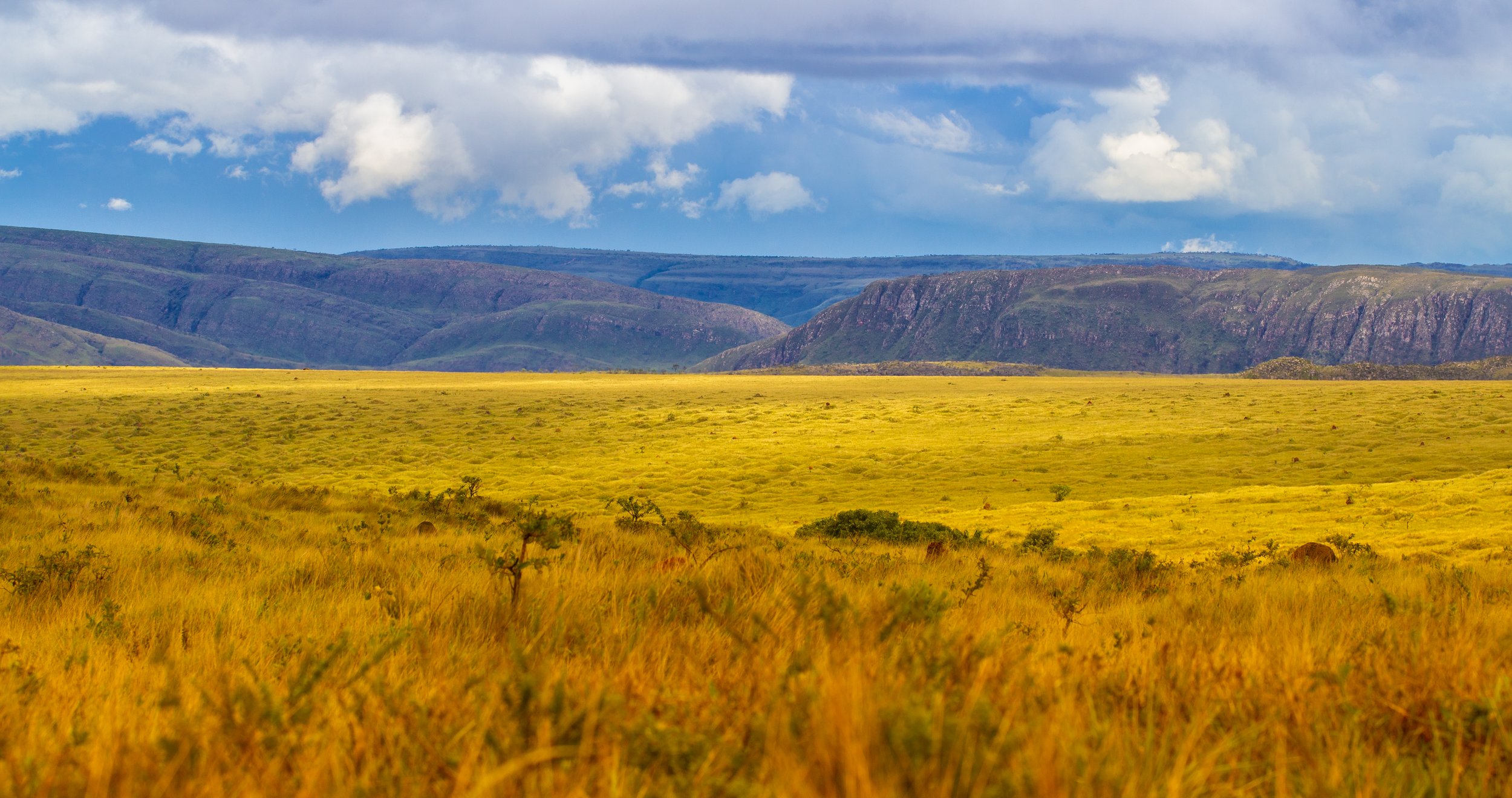November Species of the Month: River Jewelwing (Calopteryx aequabilis)
This month’s DSA species’ focus is the River Jewelwing (Calopteryx aequabilis). They are in the family Calopterygidae, known as the broad-winged damselflies. River Jewelwings are large damselflies, measuring a little over one-and-a-half inches to a little more than two inches (43-54 mm), and distributed widely across parts of southern Canada and the northern United States. Read on to hear veteran dragonfly chaser and former DSA officer Steve Valley tell about his close encounters with the species.
The Jewels of Cox Creek
Many years ago, I had given up on finding interesting odonates on Cox Creek in Timber Linn Park in Albany, Oregon, because it was heavily impacted by human activity. The creek is channeled between farm fields as it flows across the Willamette Valley, picking up agricultural runoff. In Timber Linn Park, it flows into a small man-made lake that has a large population of ducks and geese, and also hosted a “timber carnival” with all sorts of water-based human activities, from 1941-2000.
Cox Creek in Timber Linn Park, Albany, Oregon is a little odonate wilderness in a city. Photo by Steve Valley, 2023.
Over the years, all the interesting odonate habitats in my area had become filled in or degraded with pollution and/or invasive plants. Then, several years ago, I discovered a nice population of River Jewelwings (Calopteryx aequabilis) on Cox Creek. It’s a fitting name for the genus: Calopteryx: from the Greek means "kalos" (beautiful), and "pteron" translates as wing or feather.
Prior to this discovery the nearest population was 30 minutes to an hour’s drive away from my home. Now I had them on a little stream five minutes from home. Not only were there Jewelwings, but also American Rubyspots (Hetaerina americana).
A male Calopteryx aequabilis perched on a yellow flower. I have tried getting shots of one perched on these yellow flowers for 4 seasons and finally got as close as I could focus for about 10 minutes! Photo by Steve Valley 5-Jul-2023, Cox Creek in Timber Linn Park, Albany, Oregon.
A female Calopteryx aequabilis perched on a willow leaf surveys her territory. Photo by Steve Valley 15-Jul-2022, Cox Creek in Timber Linn Park, Albany, Oregon.
Cox Creek has turned out to be very productive, with a rich species diversity for a habitat surrounded by a city, next to a small local airport and a freeway. There, at the stream—wading, observing, and photographing—it is almost as if I have been transported to my own little wilderness.
River Jewelwings are large damselflies with dark semi-translucent wings. Both sexes have structural metallic colored bodies with the male being predominantly dark bluish green and the female being a lighter bronzy green. Structural colors are caused by the refraction of certain colors of light rather than being from colored pigments, but in insects pigments are often involved also. The wings of the males are black on the distal half beyond the nodus and a smoky translucent on the proximal half. The costa vein is also metallic bluish green. The female’s wings are dark, smoky and translucent with a white pseudostigma located where you would find the stigma in other damselfly species’ wings. Both sexes use the wings for various displays (stay tuned!).
An immature female, note the light colored eyes and subtle metallic colors on the face and the distinctive antennae with the L-shaped scape. Photo by Steve Valley 24-May-2022, Cox Creek in Timber Linn Park, Albany, Oregon.
A mature female, note the eyes have darkened and the metallic areas on the face have shifted to mostly reddish and much of the face has darkened including part of the antennae scape. A slight shift in perspective also shows the lightening of the area around the mouth. Photo by Steve Valley 14-Aug-2023, Cox Creek in Timber Linn Park, Albany, Oregon.
An immature male with light orange eyes and fairly bright metallic areas of the face. Photo by Steve Valley 16-May-2023, Cox Creek in Timber Linn Park, Albany, Oregon.
A mature male, note the eyes have darkened to almost black and much of the face has darkened as well. Photo by Steve Valley 20-Jul-2022, Cox Creek in Timber Linn Park, Albany, Oregon.
I have been fortunate to see all five North American Jewelwing species. All are large, showy damselflies with complex behaviors. In 2020, early in the Covid pandemic, I started visiting Cox Creek daily with my camera, attempting to shoot any odonates that would let me approach closely. I had lots of time to closely observe the River Jewelwings, which can be amazingly wary, but it did seem that they slowly became acclimatized to my presence.
I was surprised when the Cox Creek population turned out to be the largest, densest population of River Jewelwings I have ever encountered. They were usually the earliest species I would see in the mornings, and stayed active until six to seven pm. I primarily concentrated my observations along a 200 meter length of stream (about 650 feet), but spent about 75 percent of my time on a 50 meter (about 164 feet) stretch in the middle of that. I noted that some males seemed to defend the same territories on multiple sequential days, sometimes from the same favored perch. While perched, both males and females will occasionally flare their wings open and closed.
A male flares its wings. Photo by Steve Valley 30-Jun-2022, Cox Creek in Timber Linn Park, Albany, Oregon.
Sometimes it seems to be a display in response to members of the same sex perching nearby, but other times there is not an obvious (to me) target of the display.
Both sexes also often slide their abdomen up between their wings (I call this the “wing envelope” posture), but I don’t know if this pose is a display for nearby River Jewelwings or perhaps a way of regulating abdomen temperature.
A male in the “wing envelope” posture that seems to be their default preferred resting position. Photo by Steve Valley 30-Jun-2022, Cox Creek in Timber Linn Park, Albany, Oregon.
Males are aggressively territorial with other males and will lunge at rival males that land nearby. These interactions can escalate into aerial dogfights that may last up to 10 minutes. They may be joined by males in adjacent territories, and include intricate high-speed chases which can cover 30 meters (about 100 feet) of stream length. Sometimes peripheral males will sneak in and try to occupy the territory while the residents are distracted.
Males perform a distinctive display directly in front of and very close to females where they hover, bobbing up and down slightly. The pattern of wingbeats when they are doing this maneuver is distinct from all other flight and it is usually performed close to the water surface. Then occasionally, the male will balance on the tips of his hindwings on the water surface in a truly extraordinary “cross display”.
A male performs the cross display where he balances on the tips of his hindwings on the surface of the water. This amazing shot was made by Steve Russell who wrote: “A male River Jewelwing damselfly does his best to entice the female he is chasing to mate with him. Having witnessed this many times now, I am certain that he skims his wings on the water on purpose as part of the "dance." Alas, she rebuffed him and he returned to his strategic perch ready to try again. Photo by Steve Russell 3-Jul-2023, , Black River, Grays Harbor Co., Washington.
We can speculate about how this suite of behaviors developed and evolved, but it looks like fertile ground for more observations and experimentation.
Females also seem to exhibit territorial behavior toward neighboring females by hopping around and landing near intruding females and making frequent wing flare displays.
A young female starts to flare her wings at a nearby female. Photo by Steve Valley 29-Jun-2022, Cox Creek in Timber Linn Park, Albany, Oregon.
I have also observed females landing in front of males and displaying. They often perch just a bit above the male. Over the course of five to 15 minutes, they will hop down closer until the male flies up and grasps her to copulate.
A female approaches a male from above as he displays just prior to copulation. Photo by Steve Valley 16-Jul-2022, Cox Creek in Timber Linn Park, Albany, Oregon.
Copulation can last for more than an hour. The male will lead the female in tandem down to the portion of the stream where he wants her to oviposit. She then submerges and will spend 10-30 minutes clinging to the plant and ovipositing under the watchful eyes of her mate. On Cox Creek, the eggs are inserted into submerged plants that are rooted in the stream bottom and wave in the current, occasionally reaching the surface where she will land.
I watched a lone female enter a male’s territory and attempt to oviposit, only to be attacked by the male who hovered in front of her and repeatedly bumped her until she flew off. His female immediately landed and began ovipositing while I photographed her.
A female oviposits while completely submerged, often for 30 minutes or more, with a bubble of air trapped between her wings that acts as an aqualung. The male usually is perched nearby the whole time observing. Photo by Steve Valley 22-Jul-2022, Cox Creek in Timber Linn Park, Albany, Oregon.
A female oviposits while completely submerged, often for 30 minutes or more, with a bubble of air trapped between her wings that acts as an aqualung. The male usually is perched nearby the whole time observing. Photo by Steve Valley 22-Jul-2022, Cox Creek in Timber Linn Park, Albany, Oregon.
After observing this population for four seasons, I have the impression that at least some pairs form a pair-bond that endures for multiple days. In 2024, I hope to conduct marking studies to confirm or refute that hypothesis and to broaden my understanding of River Jewelwing adult behavior dynamics.
Steve Valley is a founding member of DSA, and served as its secretary for many years. He started studying odonates in the 1950s and photographing them in the 1960s when he was a teenager. He was an entomologist and insect imaging specialist at the Oregon Department of Agriculture for many years, and a pioneer in the field of extreme macro focus stacking using high resolution microscope optics and cutting edge digital cameras. Since his retirement in 2017, he has concentrated his extreme macro work on odonates rather than invasive pest insects with his own custom built imaging system. He lives in Albany, Oregon with his wife Robin.
Steve would like to express his thanks to his wife, Robin, for proofreading and suggestions, and to Steve Russell for permission to use his spectacular photo included in this post.


































































